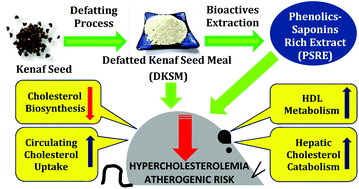Dietary supplementation of defatted kenaf (Hibiscus cannabinus L.) seed meal and its phenolics–saponins rich extract effectively attenuates diet-induced hypercholesterolemia in rats
Abstract
Kenaf is one of the important commercial fiber crops worldwide and defatted kenaf seed meal (DKSM) is a secondary by-product from the kenaf industry. Thus, efforts to turn this low-cost agricultural waste into value-added functional food ingredients will definitely bring advantageous impacts to the community health, environment and economy. The present study was aimed to investigate the cardioprotective properties of DKSM and its phenolics–saponins rich extract (PSRE) in diet-induced hypercholesterolemic rat model. Hypercholesterolemia was induced in Sprague-Dawley rats via atherogenic diet feeding and dietary interventions were conducted by incorporating DKSM (15% and 30%) and equivalent levels of PSRE (2.3% and 4.6%, respectively, equivalent to the total content of phenolics and saponins in DKSM groups) into the atherogenic diets. After 10 weeks of DKSM and PSRE supplementation, the hepatosomatic index, hepatosteatosis, serum lipid profile, Castelli risk indexes as well as hepatic and renal functions of hypercholesterolemic rats were significantly improved (p < 0.05). Besides, the levels of hepatic Hmgcr and serum Pcsk9 were lowered, along with transcriptional upregulations of hepatic Cyp7a1, Abca1, Lcat, ApoA2 and ApoE (p < 0.05). The gene expression of hepatic Ldlr was marginally enhanced by DKSM supplementation (p > 0.05), but superiorly upregulated by PSRE (p < 0.05). The combined results showed that hypercholesterolemia and the atherogenic risk in rats were effectively attenuated by DKSM and PSRE supplementation, possibly via modulations of multiple vital processes in hepatic cholesterol metabolism. Furthermore, phenolics and saponins may be the bioactives conferring DKSM and PSRE with their anti-hypercholesterolemic properties. In conclusion, DKSM and PSRE are prospective cardioprotective functional food ingredients for hypercholesterolemic individuals.



 Please wait while we load your content...
Please wait while we load your content...